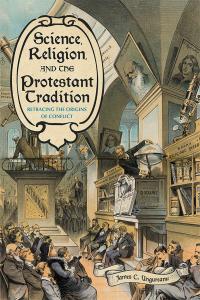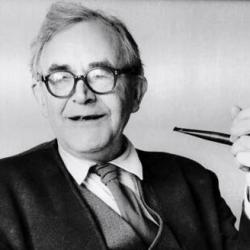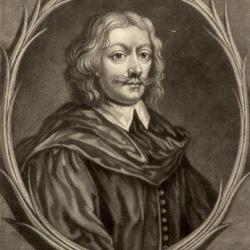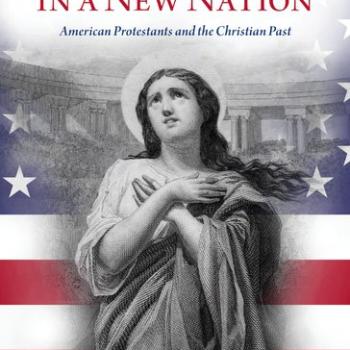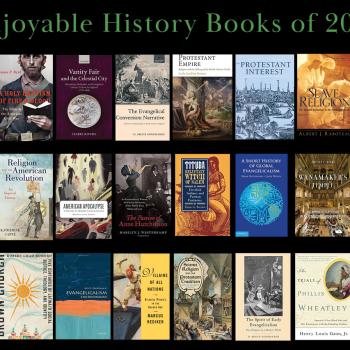Today we have the pleasure of welcoming James C. Ungureanu (PhD, University of Queensland) as a guest contributor to the Anxious Bench. He is an intellectual historian and teacher of Faith and Culture at Stony Brook School, Long Island, NY. He serves as Honorary Research Fellow at the Institute for Advanced Studies in the Humanities at the University of Queensland. He is the author of Science, Religion, and the Protestant Tradition: Retracing the Origins of Conflict (University of Pittsburgh Press, 2019), and co-author, with David Hutchings, Of Popes and Unicorns: Science, Christianity, and How the Conflict Thesis Fooled the World (Oxford: Oxford University Press, 2022). This post is published in tandem with the release of CFH’s recent book talk with Dr. Ungureanu about his book, Science, Religion, and the Protestant Tradition, which you may listen to at the CFH Podcast.
In recent years, there has been an explosion of popular-level studies on the history of science and religion. Take, for example, Derrick Peterson’s winsome Flat Earth and Fake Footnotes, acutely subtitled, The Strange Tale of How the Conflict of Science and Christianity was Written Into History (2021). Or the similarly accessible treatment of Michael Keas’s Unbelievable: 7 Myths About the History and Future of Science and Religion (2019). Or yet another, somewhat more scholarly account, found in Ron Numbers’s Galileo goes to Jail and Other Myths about Science and Religion(2009). Indeed, both Peterson and Keas owe a great deal to Numbers and a host of other scholars who have, for several decades now, carefully examined (and re-examined) the relationship between science and religion.
All these scholars have tried to make sense of the belief that science and religion are at war. This is what they mean when they refer to the “conflict thesis,” the idea that science and religion are fundamentally and irrevocably at “war” or in “conflict.” The conflict thesis has been used by many as a metanarrative, an overarching view that encompasses the entire course of Western civilization. Indeed, it attempts to explain how the modern secular person came to be.
Historians typically trace the origins of this thesis to the late nineteenth century, specifically among Anglo-American writers. For instance, many point to the so-called scientific naturalists, a Victorian coterie made up of biologist Thomas H. Huxley (1828–1895), physicist John Tyndall (1820–1893), and evolutionary philosopher Herbert Spencer (1820–1903), among others, who supposedly employed the thesis in their attempt to professionalize and secularize the sciences. More precisely still, most scholars see New York University chemist John William Draper (1811–1882) and historian and first president of Cornell University Andrew Dickson White (1832–1918) as cofounders of a philosophy of history that has promulgated the belief that science and religion have been and always will be at odds.
There is a great deal of truth here. Indeed, Draper, who published a book in 1874 entitled History of the Conflict between Religion and Science, claimed that the history of science was “a narrative of conflict of two contending powers.” He believed that faith in its nature is “unchangeable, stationary,” whereas science is “progressive.” White, who published the massive, two-volume History of the Warfare of Science with Theology in Christendom in 1896, also spoke of the “battle-fields of science,” contending that history reveals the “great sacred struggle for the liberty of science.” But historical movements can rarely be explained in such simplistic terms. In the last few decades especially, historians have scrutinized the narratives of Draper and White and found them completely wanting. They have rightly debunked many of the “myths” about science and religion.[1]
To a certain extent, however, these historians of science themselves are guilty of “mythologization.” While it is true that there are many “myths” about the conflict between religion and science, the idea that the nineteenth century witnessed the inception of the “conflict thesis” is not entirely accurate either. What is more, we are only now beginning to recognize that many of the accused did not, in fact, envision a conflict between science and religion at all. What is often missed in their discussions of Draper and White is an appreciation of the wider religious context in which such historical narratives first appeared.
The Emerging “New Religion” of the Nineteenth Century
The nineteenth century witnessed a marked development in human understanding, learning, and modern scientific investigation. But it was also the century where traditional Christian beliefs were put under severe duress. Advances in the natural and historical sciences, intentional or not, seemed to many a direct assault on Christianity. Debates about the character of religion raged both within and without the church, and out of these debates emerged new ways of thinking about the nature of Christian faith, the historical existence of Jesus, the character and authority of Scripture, the nature of the church, and the future of religion. It was a time of much doubt and disillusionment. As scholar of religion Linda Woodhead put it, the nineteenth century witnessed the “reinvention” of Christianity.[2]
This new “reinvented” Christianity was part and parcel of nineteenth-century liberal Protestantism. Recognizing that advances in the sciences and historical criticism had supposedly contradicted established religious ideas, many attempted to ameliorate the emerging malaise by readjusting or reconstructing the meaning of religion; that is, nineteenth-century liberal Protestantism generally responded to higher criticism and scientific naturalism by transforming rather than abandoning the faith. By the last decades of the century, the “New Theology” or “new religion” movement had found numerous supporters on both sides of the Atlantic.[3]
What this new or freer religion looked like was, of course, deeply contested. But however it was conceived, many men and women in the nineteenth century believed that the reconciliation of science and religion depended on it. Significantly, one key strategy used by liberal Protestants and dissident intellectuals at the end of the century was turning “theology” into a pejorative. By contrasting the idea of a free, progressive scientific inquiry against the authoritative, reactionary methods of theology, religious liberals imagined dogma as an obstacle of modern thought, not faith. Thus “conflict” occurred, they believed, not between scientific truth and religious truth, but between contesting theological traditions. If religion would only rid itself of dogmatism and ecclesiastical authority, then science and religion would be in harmony. The distinction between and separation of religion and theology was thus extremely important—indeed, the future of religion depended on it. Many liberal Protestants believed that the separation of religion from theology was the best approach to bridging the growing schism between modern thought and ancient faith, and thus for bringing about reconciliation between science and religion.
The Need for a More “Reasonable” Faith
The separation of religion from theology of course antedates the late nineteenth century. In seventeenth- and eighteenth-century England, theologians and natural philosophers attempted to establish a more “rational” foundation for Christian belief. These Protestants promoted a “reasonable” creed against the superstition and irrationality of Puritan enthusiasts and Catholics alike. Recourse to “reason” had become a litmus test. Knowledge of the natural and the supernatural came from the use of reason; and for a growing group of intellectuals, reason and religion developed a holy alliance. This attitude toward reason and religion reached its high-water mark in the teaching and writings of the so-called Cambridge Platonists, a loose-knit group of divines that included men like Benjamin Whichcote (1609–1683), Henry More (1614–1687), Ralph Cudworth (1617–1688), John Smith (1618–1652), Nathaniel Culverwell (1619–1651), and others.
Whatever their differences, this band of Cambridge men pursued the reformation of religion along more rationalistic lines. In prose, sermons, and poems, they declared that external forms were unimportant and that religion should be pared down to the essentials. They therefore underplayed dogmatism and opposed superstition, enthusiasm, and fanaticism. Concomitantly, they also placed more emphasis on the inner spiritual light than on outward rules of worship and propositional beliefs. The rational theologies of the Cambridge Platonists put an emphasis on the relationship between core religious doctrines, natural law, and a personal divine providence, with evidence for this intrinsic relationship to be found in the ideas already present in the mind, in the natural world, in the associated records or observations of the experimental philosophers, and in history. “Religion” for the Cambridge Platonists referred to primarily a “rational Christianity” of some kind, particularly a rational Protestantism.[4]
The ideas expressed in the writings of the Cambridge Platonists formed a vital link to subsequent developments in English thought. Numerous scholars have noted the close association between the Cambridge Platonists and English Latitudinarian divines, who similarly sought to minimize doctrinal discord by emphasizing human reason in understanding revelation. Indeed, the tendencies of the Cambridge Platonists found fuller expression in the rational theology of the Latitudinarians, which included such men as William Chillingworth (1602–1644), John Wilkins (1614–1672), Simon Patrick (1626–1707), Isaac Barrow (1630–1677), John Tillotson (1630–1694), Edward Stillingfleet (1635–1699), Joseph Glanvill (1636–1680), and Gilbert Burnet (1643–1715), among others.[5]
The Latitudinarians considered their rational theology both a defense against atheism and a deliberate attempt at integrating the new science with traditional religious thought. The increasing “mechanization” of nature during the eighteenth century provided new visions of God and, concomitantly, new “physico-theological” treatises. Writers such as Walter Charleton (1619–1707), Robert Boyle (1627–1691), John Ray (1627–1705), Isaac Barrow (1630–1677), Christopher Wren (1632–1723), Robert Hooke (1635–1703), Richard Bentley (1642–1726), Isaac Newton (1642–1727), Samuel Clarke (1675–1729), William Whiston (1667–1752), William Derham (1657–1735), and many others believed the new natural philosophy could be used in defense of Christianity. However, as with the Cambridge Platonists and the Latitudinarians, these “English virtuosi” sought to demonstrate not only how God has revealed himself in nature, but also how a more “rational” Protestantism provided an atmosphere more conducive to the sciences.[6]
It is important to point out that the emphasis on reason and nature shifted the focus of religion away from sin, grace, and redemption. Reason and nature thus came to overshadow revelation in many respects. But the rational theology of the Cambridge Platonists, Latitudinarian divines, and English physico-theologians would eventually come to undermine the very reasonableness of orthodox Christianity itself. Indeed, English rational theology of the seventeenth century laid the foundations for the deistic critique of revelation in the eighteenth century, as philosopher Charles Taylor has observed.[7] Rather than limiting the true faith to those fundamental doctrines shared by all Christians, the English deists simply broadened the perspective and located “true faith” in the “religion of nature”—that is, in those basic rational beliefs supposedly shared by all men in all ages.
Thus when the English deists first appeared, they had an abundant selection of Protestant rhetorical strategies and natural theologies that supported their critique of orthodox Christianity. With a more diffusive Christianity emerging, men—such as Edward, Lord Herbert of Cherbury (1583–1648), Charles Blount (1654–1693), Matthew Tindal (1656–1733), Thomas Woolston (1669–1733), John Toland (1670–1722), Anthony Collins (1679–1729), Thomas Morgan (d. 1743), Thomas Chubb (1679–1747), Conyers Middleton (1683–1750), and Peter Annet (1693–1769)—promoted a noninstitutional and therefore nonpartisan and nondogmatic “natural religion.” These deists consistently condemned revealed religion in general and Christianity in particular.
But the English deists were neither atheists nor even deists in an exclusive or final sense. Most of them in fact denied the sobriquet! The English deists did, of course, reject the Athanasian Creed and denied the divinity of Christ. They reduced religion to what they regarded as its most foundational, rationally justifiable elements. But so did many Protestant thinkers. What is clear, then, is that these men had taken the views of the Cambridge Platonists, Latitudinarians, and English natural theologians to their logical conclusions. They extended the Protestant historical and rational critique against Catholicism to Anglicanism and argued that all hierarchical established churches should be replaced with a noninstitutional “natural religion.”
A New “Science” and New “Religion” at the Turn of the Century
At the dawn of the nineteenth century, the English tradition of physico-theology culminated in Archdeacon William Paley’s (1743–1805) trilogy, Principles of Moral and Political Philosophy (1785), A View of the Evidences of Christianity (1794), and Natural Theology; Or, Evidences of the Existence and Attributes of the Deity, Collected from the Appearances of Nature (1802). Paley believed these works contained “the evidences of Natural Religion, the evidences of Revealed Religion, and an account of the duties that result from both.”[8] Thus, like the “rational theologians” before him, Paley argued that contrivance proves design. And like his predecessors, Paley’s religious views inclined toward liberalism. Indeed, one may read his natural theology as Paley’s efforts to reconcile liberal Christianity with divine providence.[9]
In the 1830s, philosophers and scientists were just beginning to try to define what exactly “science” is. In their definitions, the authors relied on existing progressive historical narratives. The astronomer and mathematician John F. W. Herschel (1792–1871), the uniformitarian geologist Charles Lyell (1797–1875), and the philosopher and historian of science William Whewell (1794–1866) are prime examples. Herschel’s Preliminary Discourse on the Study of Natural Philosophy (1830) was highly regarded by friends and colleagues. Lyell’s Principles of Geology (1830–33) is said to have initiated a “revolution” in the study of geology. Besides literally inventing the word scientist, Whewell’s History of the Inductive Sciences (1837) and Philosophy of the Inductive Sciences (1840) became the standard history of science texts for decades. The influence of these three cannot be overstated.
According to Herschel, for instance, history demonstrated that observation, experimentation, and theory building were the leading causes of the sudden growth of natural science in the time of Bacon and Galileo. The “bigots” of previous generations, he wrote, became obstacles to progress; what they did not realize was that the “testimony of natural reason . . . places the existence and principal attributes of a Deity on such grounds as to render doubt impossible.” Indeed, added Herschel, scientific progress was eclipsed for “nearly eighteen centuries, till Galileo in Italy, and Bacon in England, at once, dispelled the darkness.”[10]
While Herschel found “abstract reasoning” an obstacle to scientific progress, Lyell located it in the human tendency to revere tradition. Here, too, a progressive historical narrative played a crucial role. Throughout history, false assumptions and incomplete observations had gained cultural authority. For Lyell, organized religion was the chief transgressor. By elevating traditional beliefs to the level of the sacred and protecting them by means of social and state pressure, organized religion set enormous obstacles in the path to scientific knowledge. Loyal to concepts, they often distorted the evidence for the sake of their abstract preferences.
As a Unitarian theist, Lyell believed it was not religion that created conflict with science but rather “orthodoxy.” Indeed, he believed the very progress of human knowledge suggested continual movement away from orthodox Christian beliefs. Perhaps no single statement could sum up the “conflict thesis” as explicitly as the following: “A sketch of the progress of Geology,” Lyell asserted, “is the history of a constant and violent struggle between new opinions and ancient doctrines, sanctioned by the implicit faith of many generations, and supposed to rest on scriptural authority.”[11]Subsequent pages of his Principles of Geology were replete with examples of these sorts of “errors,” including the trial of Galileo, which he described as the “inquisitorial power which forced Galileo to abjure.” Lyell sought to tell a story in which the new science of geology, together with the human mind, was liberated from the superstitious, anthropomorphic, and theological prejudices of the past.
Whewell shared Herschel’s and Lyell’s concerns regarding the intrusion of religious doctrine into the affairs and practice of science. He found in the Galileo affair a stinging example of such an error and pointed out the long-standing negative repercussions for the church that resulted from it and warned against the dual errors of seeking “a geological narrative in theological records.” Moreover, on Whewell’s account, the advance of science suffered from “stationary” periods. What was the cause of these periods of stagnation? His explanation was that they failed to cultivate clear “fundamental scientific ideas,” and this in turn was linked with the authority of the church. The thinkers of previous generations were possessed by a spirit of “mysticism,” which pursued either particulars or wild generalizations. Thus “their physical science became Magic, their Astronomy became Astrology, the study of the Composition of bodies became Alchemy.” Whewell spoke of the “Indistinctness,” the “Dogmatism,” and the “Mysticism” of the Middle Ages, and even complained of the medieval belief of a flat earth. Here Whewell’s work bears testimony to the influence of “conflict,” demonstrating that he, too, was the recipient of a preexisting narrative trope regarding the engagement between natural philosophy and religion.[12]
In subsequent decades, a host of Victorian scientists, dissident intellectuals, radical Dissenters or Nonconformists, and even liberal Anglicans sustained in their language strong traces of a Protestant polemic against superstition, corruption, authority, and even apostasy from what they believed was the true message of Christ. Figures as diverse as George Combe (1788–1858), Robert Chambers (1802–1871), Francis W. Newman (1805–1897), James Martineau (1805–1900), William R. Greg (1809–1881), Thornton Leigh Hunt (1810–1873), George Henry Lewes (1817–1878), George Eliot (1819–1880), Arthur P. Stanley (1815–1881), Charles Kingsley (1819–1875), Charles Voysey (1828–1912), John Robert Seeley (1834–1895), William E. H. Lecky (1838–1903), and even the scientific naturalists Tyndall, Spencer, and Huxley distinguished theology from religion in the hope that the new discoveries in the natural and historical sciences would bring about a “New Reformation.”
A Conflict between “Two Contending Powers”
Draper and White themselves must be placed within the wider religious changes occurring in the century.[13]While the majority of scholarly opinion has pitted Draper and White as antagonists rather than harmonizers, a closer reading of their respective works demonstrates a more nuanced position. As chair of chemistry at the University of New York, Draper reassured his students that there exists “an intelligent principle with all its affections and feelings, and acquisitions and knowledge unaltered and untouched” by the sciences. For him, studying nature revealed the “peculiarity of the works of God.” At the same time, Draper cautioned that nature demonstrated “not a God of expedients, but a master of endless resources.” In a remarkable statement, he even claimed that to study nature was to elevate the “mind of a philosopher to a perception of the laws upon what it pleases God to govern the universe.”[14]
Furthermore, in his History of the Intellectual Development of Europe, which was published nearly a decade before his History of the Conflict, Draper argued that Christianity had been “paganized” under Emperor Constantine. In his view, the intellectual history of Europe is largely a story of the corruption of Christianity. In fact, Draper believed that early Christianity was a gift of God, whereas ecclesiastical organizations, or institutionalized religion, were the products of human invention. By the fourteenth century, he complained, “God had altogether disappeared” from organized religion. With the paganization of Christianity, however, came what Draper called the “tyranny of theology over thought.” He declared that those “who had known what religion was in the apostolic days, might look with boundless surprise on what was now ingrafted upon it, and was passing under its name.”[15] Under closer inspection, even his notorious History of the Conflict continues to make such distinctions, as when Draper argues that he would only consider the “orthodox” or “extremist” position, and not the moderate ones. As so many others during the century, Draper’s narrative was organized loosely around an argument sanctioned by progressive narratives similar to Herschel, Lyell, Whewell, and the others. A drama of heroes and villains, friends and enemies, a gripping narrative presented as a moral lesson. Using images of conflict to generate public support for science, Draper represented history as the irreversible progress of western civilization.
White shared much of the same sentiments. By separating religion from theology, White was able to denounce that the “most mistaken of all mistaken ideas” was the “conviction that religion and science are enemies.” While science has conquered “dogmatic theology,” he argued, it will “go hand in hand with Religion.” For White, science was an aid to religion, encouraging its “steady evolution” into more purified forms. White also believed that Jesus had preached a “pure and undefiled religion,” and that the present conflict “was the fault of that short-sighted linking of theological dogmas to scriptural text which, in utter defiance of the words and works of the Blessed Founder of Christianity, narrow-minded, loud-voiced men are prone to substitute for religion.”[16] Later, in his 1919 Autobiography, White concluded that history had demonstrated that:
While the simple religion of the Blessed Founder of Christianity has gone on through the ages producing the noblest growths of faith, hope, and charity, many of the beliefs insisted upon within the church as necessary to salvation were survivals of primeval superstition, or evolved in obedience to pagan environment or Jewish habits of thought or Greek metaphysics or medieval interpolations in our sacred books.[17]
For White, science was an aid to religion, encouraging its “steady evolution” into more purified forms.
The Unintended Consequences of the “New Theology”
But the liberal Protestant reformulation of religion was a risky strategy that ultimately backfired. A new generation of religious skeptics and unbelievers saw such liberal attempts at reformulating the idea of God and religion as gratuitous and unnecessary. Perhaps the most important secularist to have arrogated Draper and White, and liberal Protestant historiography in general, was Joseph McCabe (1867–1955). A Roman Catholic monk who abandoned his religious beliefs around 1895, McCabe wrote over two hundred books on science, history, and religion. A vehement advocate of atheism, McCabe frequently forecast the doom of Christianity in light of modern science. In his massive and important Biographical Dictionary of Modern Rationalists (1920), McCabe included both Draper and White in his tribute. McCabe also published an extremely popular pamphlet titled The Conflict between Science and Religion (1927), in which he essentially repeated elements of the narratives of both Draper and White. But unlike them, McCabe gleefully cheered on the decay of religion all over the world. Future historians, he argued, will look back with amusement at those men of science and theologians of his own century who protested that there was no conflict between religion and science. “He will read the priests protesting,” he wrote, “that there is no conflict between true science and religion, and the professors plaintively chanting that there is no conflict between science and true religion.” But according to McCabe, the historians of the future will recognize that “science has, ever since its birth, been in conflict with religion.” Indeed, the vast majority of McCabe’s short book was a diatribe against progressive or “modernist religion.” Ironically, he repeated the same arguments of conservative and orthodox opponents of Draper and White, calling liberal Protestantism the “veriest piece of bunk that Modernism ever invented.” According to McCabe, those liberal theologians who reinterpreted traditional religious belief, wittingly or unwittingly, attacked the very foundations of Christianity. The modernists, McCabe concluded, “are Christians who believe that Paul and the Christian Church have been wrong in nearly everything until science began to enlighten the world.”[18]
Thus, in a remarkable twist of irony, both orthodox believers and radical unbelievers found themselves in concord. If theology was found unbelievable or unnecessary, then so must be religion. The narratives of liberal Protestant thinkers were, in short, appropriated by skeptics, who reshaped them to justify and promote their own specific vision of a progressive and secular society. Skeptics near the end of the nineteenth century and the beginning of the twentieth century declared war not only on traditional religious believers but also on what McCabe caustically described as the “land of bunk,” those obfuscating religious modernists who attempted to accommodate theology to fit the modern age.
Many in the nineteenth century believed the “New Theology” would bring reconciliation between modern science and faith. “Conflict” occurred, many believed, not between scientific truth and religious truth, but between contesting theological traditions. The scientific naturalists Huxley, Tyndall, Spencer, and even Draper and White, all made such a distinction between theology and religion. What enabled them to make these distinctions were the changes in religious thought that had occurred during the previous centuries. In short, Draper and White believed that theology was not only in conflict with science but also with religion. They envisaged the conflict as one between conservative and liberal theological traditions. This history, in other words, is one in which one theological tradition was pitted against another—a more progressive, liberal, and diffusive Christianity against a more traditional, conservative, and orthodox Christianity.
And upon deeper reflection, this conflict predated the nineteenth century. Such narratives of theological conflict appeared in Protestant historiography as early as the seventeenth century, among Anglo-American Protestants in particular. As far back as the sixteenth century, Protestant reformers used a rhetoric of history, reason, and natural philosophy in their attack on the Catholic Church. But this history of polemic also demonstrates that these rhetorical strategies often have unintended consequences. By the eighteenth century, more liberal Protestants used the same polemic of history, reason, and science against their orthodox opponents. In time, then, such polemics were transformed from Protestant, anti-Catholic sentiment to an intra-Protestant, self-critique, particularly between liberal and conservative Protestants.
Nourished in this religious context, by the mid-nineteenth century, narratives of conflict between “science and religion” were largely deployed between contending theological schools of thought. It was not until the end of the nineteenth century and the beginning of the twentieth century that these narratives were appropriated by secularists, freethinkers, and atheists as weapons against all religion. Thus the notion that science and religion are inherently at war with each other did not emerge from secular society but from conflicting religious traditions. In short, the origins, development, and popularization of the “conflict thesis” in the nineteenth century was, in part, an unintended consequence of liberal Protestant thought. Having a more accurate understanding of the “conflict thesis” as one that originated within contending religious traditions gives us a better understanding not only of how it developed, but also why it continues to persist despite decades of scholarship telling us it is false.
[1] See, e.g., Ronald L. Numbers, ed., Galileo Goes to Jail and Other Myths about Science and Religion (Cambridge, MA: Harvard University Press, 2009).
[2] Linda Woodhead, ed., Reinventing Christianity: Nineteenth-Century Context (Aldershot, UK: Ashgate, 2001).
[3] Gary Dorrien, The Making of American Liberal Theology: Imagining Progressive Religion, 1805–1900 (Louisville, KY: Westminster John Knox Press, 2001).
[4] See, e.g., C. A. Patrides, ed., The Cambridge Platonists (Cambridge: Cambridge University Press, 1969); John Gascoigne, Cambridge in the Age of Enlightenment: Science, Religion and Politics from the Restoration to the French Revolution (Cambridge: Cambridge University Press, 1989).
[5] See, e.g., Martin I. J. Griffin, Latitudinarianism in the Seventeenth-Century Church of England (Leiden: Brill, 1992); W. M. Spellman, The Latitudinarians and the Church of England, 1660–1700 (Athens: University of Georgia Press, 1993).
[6] See, e.g., John Dillenberger, Protestant Thought and Natural Science: A Historical Interpretation (London: Collins, 1961); Richard S. Westfall, Science and Religion in Seventeenth-Century England (Hamden, CT: Archon Books, 1970); R. Hooykaas, Religion and the Rise of Modern Science(Edinburgh: Scottish Academic Press, 1972); Charles Webster, The Great Instauration: Science, Medicine and Reform, 1626–1660 (London: Duckworth, 1975); and Margaret Jacob, The Newtonians and the English Revolution, 1689–1720 (Hassocks: Harvester Press, 1976).
[7] Charles Taylor, A Secular Age (Cambridge, MA: Harvard University Press, 2007), esp. 221–26.
[8] William Paley, Natural Theology, Or Evidences of the Existence and Attributes of the Deity, Collected from the Appearances of Nature (London: S. Hamilton, 1813).
[9] D. L. LeMahieu, The Mind of William Paley: A Philosopher and His Age (Lincoln: University of Nebraska Press, 1976).
[10] John F. W. Herschel, A Preliminary Discourse on the Study of Natural Philosophy (London: Longman, Brown, Green & Longmans, 1851 [1830]), 7-8, 72.
[11] Charles Lyell, Principles of Geology, 4 vols. (London: John Murray, 1837 [1830-33]), 1.44.
[12] William Whewell, History of the Inductive Sciences: From the Earliest to the Present Times, 3 vols. (London: John W. Parker, 1837), 1.215, 233.
[13] Here I summarize the material in my Science, Religion, and the Protestant Tradition: Retracing the Origins of Conflict (Pittsburgh: University of Pittsburgh Press, 2019).
[14] Cited in Ungureanu, Science, Religion, and the Protestant Tradition, 30.
[15] John William Draper, A History of the Intellectual Development of Europe (New York: Harper & Brothers, 1863), 198, 382-402.
[16] Andrew Dickson White, The Warfare of Science (New York: D. Appleton & Co., 1876), 7-10; A History of the Warfare of Science with Theology in Christendom, 2 vols. (New York: D. Appleton & Co., 1896), 1.v-xii, 410.
[17] Andrew Dickson White, Autobiography, 2 vols. (New York: Century, 1905), 2.533.
[18] Joseph McCabe, The Conflict between Science and Religion, Little Blue Book No. 1211 (Girard, KS: 1927), 5-6, 7, 12, 24.



